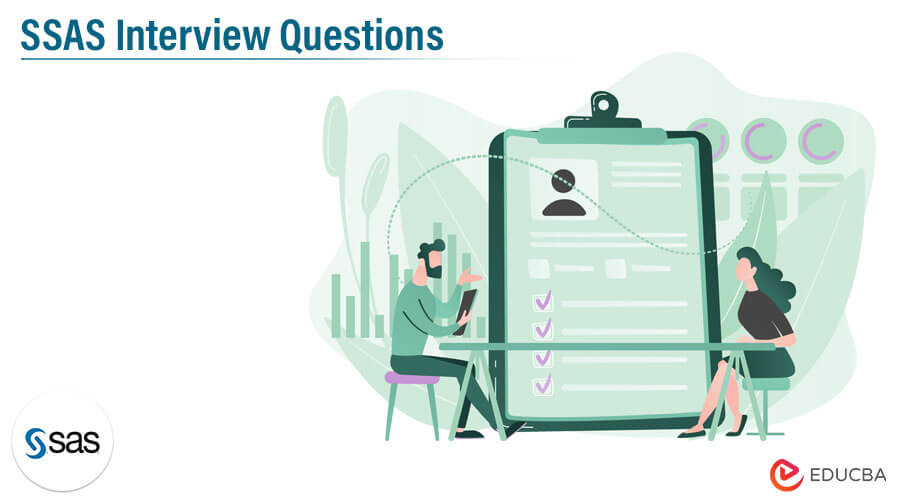Updated June 15, 2023

Introduction to SSAS Interview Questions and Answers
SQL Server Analysis Services (SSAS) is a data mining tool developed by Microsoft which is used for Online Analytical and Transaction Processing and data mining in Microsoft SQL Server. SQL Server Analysis Services (SSAS) is a technology from Microsoft Corporation from its Business Intelligence unit.
So If you are looking for a job related to SSAS, you must prepare for the 2023 SSAS interview questions. Though every SSAS interview is different and the job scope is also different, we can help you with the top SSAS Interview Questions and answers, which will help you take the leap and succeed in your SSAS interview. Keeping this in mind, we have designed the most common SSAS Interview Questions and answers to help you get success in your interview.
Top SSAS Interview Questions
Below is the list of 2023 SSAS Interview Questions that are mostly asked :
1. What are SQL Server Analysis Services (SSAS)?
Answer:
SQL Server Analysis Services (SSAS) is an Online Analytical Processing (OLAP) component in the SQL Server. Online Analytical Processing (OLAP) has a concept called cubes that was released in Microsoft System Center 2012 Service Manager Version. These cubes can provide an efficient searching mechanism for large volumes of data and can also sum up large amounts of data and retrieve any data points.
Also, Online Transaction Processing (OLTP) allows business users to keep all the transactions and records in OLTP databases, a feature of SQL Server Analysis Services (SSAS). An Online Analytical Processing (OLAP) cube is called a hypercube or multidimensional cube.
2. What are the features of SQL Server Analysis Services (SSAS)?
Answer:
SQL Server Analysis Services (SSAS) provides different ways and approaches for creating a business intelligence model. The other models are multidimensional, tabular, or pivotal. The different model allows the users to have the additional requirements fulfilled for various business requirements in the competitive environment. Multidimensional is the latest and most mature model built on open standards and supports multiple vendors in Business Intelligence Software.
The different models that support are tabular, multidimensional, and pivotal models in Excel. A tabular model is for relational model construct having models, tables, and columns.
3. What is a Data Source View?
Answer:
A Data Source View has a logical model of the schema used in the multidimensional model of SQL Server Analysis Services (SSAS). The multifaceted model consists of cubes, dimensions, and mining data structures. A Data Source View is a metadata definition stored in XML format. A Data Source View contains metadata information representing the required objects from multiple existing data sources.
A Data Source View can contain relationships like primary keys, columns, object identifiers, etc. A Data Source View is a required and critical component in a multidimensional model of SQL Server Analysis Services (SSAS).
4. What is a Dimension Table?
Answer:
A dimension table is a fundamental component of a Cube in a multidimensional model of SQL Server Analysis Services (SSAS). A dimension table stores data with a particular relation, such as customers, stores, employees, vendors, business users, etc., establishing a relational model among the different fields or entity objects. Dimensions in SQL Server Analysis Services (SSAS) contain field attributes that show a relation similar to that of columns in a relational model.
The Dimension table storage models can be Relational or Multidimensional Online Analytical Processing (OLAP). The dimension table also describes the different attributes and their hierarchies.
5. What are the different types of Data Sources supported by SSAS?
Answer:
The supported data sources for SQL Server Analysis Services (SSAS) in the multidimensional model are Access databases, SQL Server relational databases, Oracle relational databases, Teradata relational databases, Informix relational databases, IBM DB2 relational databases, Sybase Adaptive Server Enterprise (ASE) relational databases, and few other relational databases. In contrast, the data sources supported by the tabular model are Access databases, SQL Server relational databases, SQL Server Parallel Data Warehouse (PDW), Oracle relational databases, Teradata relational databases, Informix relational databases, IBM DB2 relational databases, Sybase relational databases, Text files, Microsoft Excel files, PowerPivot workbook, Analysis Services cube, different Data feeds, and Office Database Connection files.
After installing SQL Server Data Tools (SSDT), the setup requires additional drivers to support the different data source providers. Some providers need other drivers to keep the data source, and some do not require them based on the type. The data sources supported by tabular and multifaceted models differ based on their architectural models, and most are almost similar.
Recommended Articles
We hope that this EDUCBA information on “SSAS Interview Questions” was beneficial to you. You can view EDUCBA’s recommended articles for more information.
